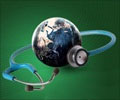Fears of radiation have caused a dip in tourism in Japan.

The guesthouses and hotels -- in a district the Michelin Blue guide gives its maximum three stars -- owe most of their business to workers helping to rebuild coastal communities shattered by the March 11 tsunami.
Matsushima escaped the worst of the disaster, its island-dotted bay breaking up the ferocity of the giant waves that devastated hundreds of kilometres (miles) of picturesque Pacific coast.
But the tourists on whom Matsushima's economy depends are few and far between.
Fears about the effect of leaking radiation from the crippled Fukushima nuclear plant 110 kilometres (70 miles) south have all but stopped the influx of visitors from China, Hong Kong, South Korea and Taiwan.
Domestic visitor numbers have also been badly hit.
Advertisement
He said the total number of visitors this year would be "two million at best", little more than half the 3.7 million seen in normal years.
Advertisement
They are daily dispatched to help rebuild washed-away towns nearby, such as the fishing port of Ishinomaki where 4,000 people were killed and debris and wrecked vehicles form huge mounds along the shoreline.
Matsushima escaped almost unscathed, with the 260 islets and odd-shaped rocks in its bay acting as a buffer against the towering waves triggered by a 9.0-magnitude offshore earthquake.
Elsewhere along the coast, waves as high as 16 metres (52 feet) swallowed ships, crushed seawalls, swept away buildings, cars and human lives.
But in Matsushima, the water rose just a few metres, washing away two bridges and flooding houses and commercial facilities including a wax museum.
Two of the town's 15,000 residents died, barely registering in a tragedy that claimed 20,000 lives across the northeast.
"Zenshin (move forward), Matsushima," reads a slogan seen everywhere in the town, which is dotted with historic sites, including the 400-year-old Buddhist temple Zuigan-ji dedicated to a local samurai warrior.
And things are moving, but only slowly.
Fukui said the number of visitors in June and July was just a quarter of what it has been in previous years. In August it was around 40 percent and peaked at 50 percent on a couple of holidays in September.
The tsunami also destroyed the oyster industry for which Matsushima was famous, washing away farms all along the rugged coast.
The shellfish is back in souvenir shops and restaurants, served in pastries or pickles, eaten raw from the shell or cooked in a hot pot. But they are not Matsushima oysters.
"Brokers are bringing in oysters from Mie," said Yasuko Sakurai, a manager at a seafood restaurant, referring to an unaffected pearl-growing region in central Japan.
"I hear that volunteers have built new oyster rafts in our region and they may start shipping out products in one and a half years."
Masaharu Mano, a senior manager of the sightseeing boat operators' cooperative, said the number of passengers peaked at 2,000 a day in mid-August, just a third of what it was last year.
"We used to see 20-30 buses every day carrying Asian tourists in the autumn season. Now we see just a few every week."
Mano said he hoped the return of regular international flights to and from the rebuilt local Sendai airport in late September would help bring back foreigners.
But he acknowledged transport was not the main thing keeping visitors away.
"We need to do away with harmful rumours associated with the nuclear plant," he said.
Japanese and foreigners alike are wary of Fukushima, where the tsunami knocked out cooling systems, causing a nuclear meltdown that sent radiation spewing into the air and sea and infecting the food chain.
The government and the plant's operator have pledged to bring the world's worst atomic disaster since Chernobyl under control by the end of the year.
But scepticism remains.
Fears over the radiation, coupled with a punishingly high yen, continue to depress the number of foreign visitors to the country as a whole, the Japan National Tourism Organisation said.
About 2.5 million foreigners visited Japan in March-August, down 44 percent from a year earlier. Of them, 547,000 came in August -- down 32 percent in what should be a peak month for overseas guests.
On a recent weekday, about 70 passengers took a noontime bay cruise aboard the 188-tonne No. 3 Nioh, which can carry 400.
Janice MacFarlane and her daughter from the Shetland Isles in the far north of Scotland were the only foreign faces on board, taking a day trip out from their base in Sendai where they were visiting another of her daughters.
"I've been watching information on the Fukushima situation," said the 56-year-old. "There was no problem coming to Sendai or Matsushima."
Tourism managers are hoping there are more people like MacFarlane. But in Matsushima at the moment, they are a rare sight.
Source-AFP











